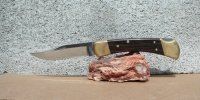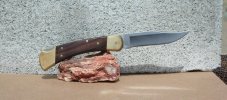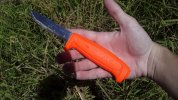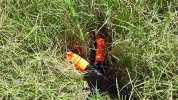afishhunter
Basic Member
- Joined
- Oct 21, 2014
- Messages
- 14,686
Not a 66, but this old Western has been a great camping knife. I wouldnt use it for regular battoning but I also wouldnt want to use most battoning knifes to fillet a fish, which the Western does pretty well, and I always have an axe or hatchet when I'm camping anyways. The modern equivilant is the Buck 105, which I think is even better. The point is alot more manageable for anything besides skinning and the straight, squared off spine is better for scaling a mess of Rockys.
RIMG0171 by C, on Flickr
RIMG0181 by https://www.flickr.com/photos/153108294@N08/, on Flickr
Wonderful selection. (I'd have difficulty choosing which would accompany me when going afield.)Since this is the traditional section, old school knives like the Mora Classic deserve mention......The Mora 1 or 2 is a good choice, but I'd go with finding a good older Erik Frost model on Ebay or where ever. Those laminated blades with the hard O1 core are really good. Mors Kochanski was a big fan of the Mora Classics also, and used them for years in his survival teachings.

As for Nordic knives, Puukkot are really good, but for general camp use I'd go with a Lappinleuku style. Stromeng makes some bulletproof leuku style knives, and if you can find an older medium sized Marttiini Lappinleuku(~6") they are really good at general stuff, even food prep.
5" Stromeng
6" Marttiini Lappinleuku
With a couple puukkot

None of these are terribly expensive either......
Also in the old school camping knife vein, the knives used by two of the best known survivalists that created the base of what we know today as camping and woodcraft, specifically Horace Kephart and George Washington Sears, are relevant. Both the Kephart and the Nessmuk are still popular today. Kephart carried a couple knives, a medium (~5") fixed blade of his design, and a small folding knife. Nessmuk carried a midsize fixed blade (~4 or 4 1/2") and a large two blade moose pattern folder. Both men used the knives extensively in their outdoor adventures and swore by them. Either fixed blade would be a good choice as they have both withstood the test of time.
Nessmuk on the left, Kephart on the right

Wise. You're also teaching them a high priced "impressive" brand name, or custom maker tool isn't necessary to get the job done.Start with a mora companion and get good with it at basic outdoor tasks then add 40 bucks lots of options open up. I'm now having my son's start out learning on my moras and more budget friendly knives.
Agree. Morakniv are hard to beat for value.Suggest @Sitcomdad83 has good advice.
Those Mora knives are stunning vfm to say the least.
If you don’t know which way your camping interests will take you, a Mora is a solid companion for starters.
If you’re going to end up using a knife for clearing, de-branching and battoning you’ll need a stout full tang knife.
Depending on your hunting and cooking skills, you may need another with finer blade.
Have fun in the big outdoors
Grab a coffee and 20mins - you'll possibly learn a few bits n pieces about camping knives from this vid - sure, there's very many vids out there, this one is plain talking. I have no interest in the knife featured, but the talk around it is highly instructive:
As for battoning ... I've never needed to do that when camping, or when I needed a fire. Generally speaking, I always manage to find enough deadfall and kindling laying around. (more often than not covering the spot I wanted to pitch my tent, and with-in 5 to 15 feet.)
If I had needed to split the wood, I usually had a belt ax/hatchet or tomahawk with me. Failing that, carving a wedge and beating on it with a rock was always an option.
Prior to joining Blade Forums, I'd never heard of beating a knife through a log/plank to split the wood. NO ONE I knew did so. It was never mentioned in the boy scout troops I belonged to through Junior High.
In the scouts we'd learned how to stress a sapling when needed to fell it using our fixed blade or 4 blade scout knife with a single cut for building a shelter, and how to cut to length by whittling around it like a beaver would a tree trunk.
For felling large branches, we had our belt/hunting axe/hatchet. At camp we had the troop leader's full size axe if needed. (NO! he taught us how to safely use it before our first swing/chop, along with how to make it fall where we wanted it to) and a pruning saw, to drop branches the axe was the wrong tool for. (he also taught us how to drop the branch straight down, without stripping bark from behind the cut, as would have happened if we made a single cut from the top down, allowing the branch pivot at the cut.
(correct two cut is: first cut bottom cut up to just before the saw would bind, then the second cut from the top, about 3 to 6 inch toward the trunk from the bottom cut.)
A couple troop mates had a pocket wire saw, or a chainsaw chain with hand grips on each end, in their kit.
I forgot to mention in my original post the Scandinavians have been using a Puukko when fishing/hunting/camping/hiking, and during war time as well as every day use, I believe since at least the mid or late 1800's ... around 200 years or so.Quality on a budget always makes me think of Morakniv. First rate blade, a good, albeit plastic handle, and a no-nonsense sheath. There are a lot of options, and you can get either carbon steel or stainless.
The Puukko pattern/type knife has definitely passed the test of time ... IMHO with a grade of "A++".








